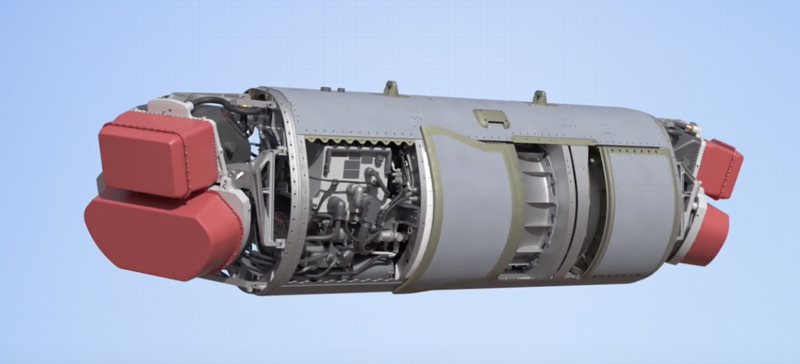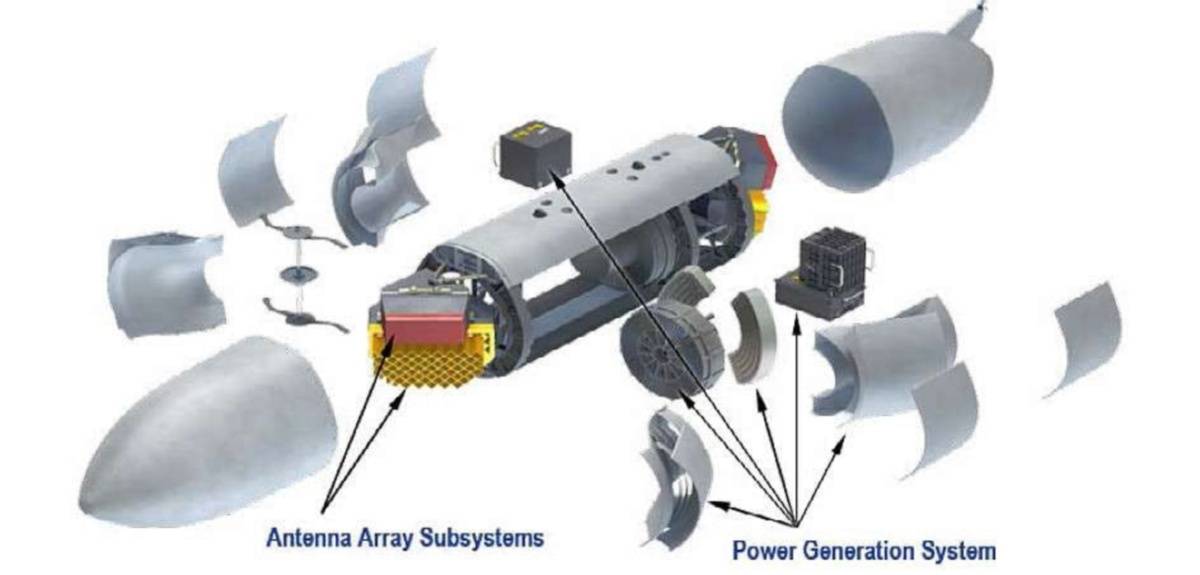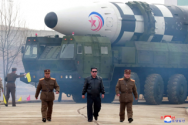You are using an out of date browser. It may not display this or other websites correctly.
You should upgrade or use an alternative browser.
You should upgrade or use an alternative browser.
US Military News, Reports, Data, etc.
- Thread starter tphuang
- Start date
U.S. Navy Eyes Next-Generation Jammer's Mid-Band IOC In Late FY24
The U.S. Navy is aiming to declare initial operational capability (IOC) for the Next-Generation Jammer’s mid-band system before the end of September after development snags set back the test schedule. The ALQ-249 jammer is designed for use on the EA-18G Growler to augment and eventually replace the...
View attachment 132245
Seems like quite the monster jammer pod.


The pod operates independently of the aircraft's systems, automatically responding to identified threats. One unique aspect of the NGJ is that its AESA array combines EW, coms, radar, and . AESA is known to perform EW and radar, but also handling SIGINT and serving as a communications array are new capabilities.
Last edited:
The sky is the limit.US nuclear missile program costs soar to around $160 billion, sources say
The cost of an Air Force program to replace aging nuclear missiles has ballooned to about $160 billion from $95.8 billion, three people familiar with the matter said, threatening to slash funding for other key modernization plans.
TerraN_EmpirE
Tyrant King
Tell me you didn’t read the report, without telling me you didn’t read the reports.The costs will continue to escalate further. They have not designed a new ICBM in like 40 years.
That is why Russia did not invest more in its conventional forces. They designed several new strategic missiles (Bulava, Yars, Avangard, Sarmat).
Like so many you jumped to the car sale price and forgot the garage, the gas, the mechanic, spare parts, car wash, oil and tires.
Yes it’s true the US hasn’t introduced a new ICBM since the PeaceKeeper. However in the late 1980s early 1990s there was the Midgetman missile system or SICBM which was supposed to be TEL launched.
Peacekeeper was also supposed to be TEL launched off the back of a Train but they plugged them into existing Silos as an interm solution because no one wants to be sitting behind an ICBM in traffic.
Which brings us to the real culprit in the cost overruns. The Silos and infrastructure. A few years back the U.S. government had to admit that the Nuclear launch system still used 8 inch floppy disks.
I have seen 8 inch Floppy discs four times in my life time. The first was in a box in Elementary School. The second at a swap meet in a dead mall. The third in a high school closet. The Fourth was in a museum exhibit. Those disks were industry standard when I was Born in 1982. By the time I entered the first grade 5 inch disks were the standard.
I used 5 inch discs in Apple 2 computers in elementary school. By the 90s those were replaced with the 3 1/4th inch hard ones. That went out by the early teens.
Because of SALT I the USAF can’t build new silos so they have to basically flip them. These are big concrete silos so they have to cut into the old structures rip out 1970s vintage equipment and wiring and plumbing and run whole new electrical, plumbing and computers. They have to build a new communications line because the old one is obsolete. New ground stations for satcoms. Hell I am pretty sure this could even go to the Nuclear football.
Because the Coldwar “ended” the nuclear triad was allowed to decline as a priority. It wasn’t until the Russians started Saber rattling about Bulava, Yars, Avangard, Sarmat that Washington realized it was long long overdue for modernization. Those Russian missiles are TEL based. So you replace the launcher with a new truck at the same time as the missiles. So it’s easier to do at the launcher missiles side. Though much of the hardware in between hasn’t seemed to really have changed.
Russia only started its next generation nuclear weapons program after George W. Bush reneged the ABM Treaty. They had to develop next generation nuclear weapons that would be harder to intercept precisely to counter US ABM systems.Because the Coldwar “ended” the nuclear triad was allowed to decline as a priority. It wasn’t until the Russians started Saber rattling about Bulava, Yars, Avangard, Sarmat that Washington realized it was long long overdue for modernization. Those Russian missiles are TEL based. So you replace the launcher with a new truck at the same time as the missiles. So it’s easier to do at the launcher missiles side. Though much of the hardware in between hasn’t seemed to really have changed.
Right now the Russians are a decade or two ahead of the US in terms of strategic weapons as a result.
TerraN_EmpirE
Tyrant King
They were going to have to do it anyway.
Nuclear weapons have a shelf life and the Russian ones have a shorter shelf life than the U.S. plus Russia has smaller boarder than the USSR and much of the old missiles were built in Ukraine. So upon the collapse spare parts and even silos and launchers were located outside of Russia.
Bush just gave them an excuse. A lame excuse too. The existing Russian ICBM system could easily have overwhelmed the small number of ABM the U.S. has. It’s always been defense against the DPRK and Iranian missiles.
Decade ahead or behind ( questionable given the exposed graft and reality of Russian Super weapons) doesn’t matter as both sides have more than enough weapons to turn the entire world into a Fallout theme park.
Nuclear weapons have a shelf life and the Russian ones have a shorter shelf life than the U.S. plus Russia has smaller boarder than the USSR and much of the old missiles were built in Ukraine. So upon the collapse spare parts and even silos and launchers were located outside of Russia.
Bush just gave them an excuse. A lame excuse too. The existing Russian ICBM system could easily have overwhelmed the small number of ABM the U.S. has. It’s always been defense against the DPRK and Iranian missiles.
Decade ahead or behind ( questionable given the exposed graft and reality of Russian Super weapons) doesn’t matter as both sides have more than enough weapons to turn the entire world into a Fallout theme park.
Last edited:
The difference is Yars would not have had MIRV capability. Avangard would have never been developed. And neither would have the Poseidon, or Burevesnik. The Iskander would also probably not have been adapted into the Kinzhal.
All those systems were developed as a counter to ABM.
The construction of Sarmat was not a done deal either. A lot of people wanted a large solid rocket deployed in trains or silos instead.
But they might have also just simply put more Yars missiles in silos. Just like they did with the Topol in the 1990s.
The whole kicker of going for a large liquid rocket is that it has much higher range and payload given the same weight. So the Sarmat can travel via the South Pole. Thus forcing to US to also spend resources on air defense in its southern border. If there was no air defense none of this would have been necessary.
And now with the US withdrawing from the INF Treaty we will also likely see Europe and the Far East covered with IRBMs.
All those systems were developed as a counter to ABM.
The construction of Sarmat was not a done deal either. A lot of people wanted a large solid rocket deployed in trains or silos instead.
But they might have also just simply put more Yars missiles in silos. Just like they did with the Topol in the 1990s.
The whole kicker of going for a large liquid rocket is that it has much higher range and payload given the same weight. So the Sarmat can travel via the South Pole. Thus forcing to US to also spend resources on air defense in its southern border. If there was no air defense none of this would have been necessary.
And now with the US withdrawing from the INF Treaty we will also likely see Europe and the Far East covered with IRBMs.
Last edited:
TerraN_EmpirE
Tyrant King
After Bush pulled the U.S. out we had maybe 44 counter missiles. 44 if each had a 100% success rate they could destroy exactly 44 Ballistic missiles. So the Russians could have defeated that with 45 missiles in a salvo. Of course 100% is an illusion for such a system.
Today we have maybe 64. How many ICBM do you think Russia has aimed at the U.S.? I have seen an estimate of about 528 active missiles. So let’s do the maths. If Russia was to fire along a trajectory where those missiles are then to counter it the GBMD would need a 825% success ratio. Because they are hit to kill that is impossible.
And if you haven’t noticed we haven’t spent anything on southern ABM or eastern ABM… only ABM to the west and North west.
Why would the U.S. place all its ABM in two bases one in Alaska the other California with not enough to counter a Russian or even Chinese ICBM launch? It’s almost like there is some third party in Asia that is unpredictable and has Nuclear weapons… but not a lot of them… because then 64 would be too few. hmmm… I wonder…

Oh but the US withdrew from the INF… because the U.S. has said for years Russia wasn’t living up to the treaty. The Yars is believed to be a violation of START based of the Topol-M, Rubezh has already been accused of a violation of the INF treaty based off the Pioneer along with the SSC 8.
So again I say Russia was going to do it anyway the U.S. Withdrawal has only been a convenient excuse to do what they were already doing.
Today we have maybe 64. How many ICBM do you think Russia has aimed at the U.S.? I have seen an estimate of about 528 active missiles. So let’s do the maths. If Russia was to fire along a trajectory where those missiles are then to counter it the GBMD would need a 825% success ratio. Because they are hit to kill that is impossible.
And if you haven’t noticed we haven’t spent anything on southern ABM or eastern ABM… only ABM to the west and North west.
Why would the U.S. place all its ABM in two bases one in Alaska the other California with not enough to counter a Russian or even Chinese ICBM launch? It’s almost like there is some third party in Asia that is unpredictable and has Nuclear weapons… but not a lot of them… because then 64 would be too few. hmmm… I wonder…

Oh but the US withdrew from the INF… because the U.S. has said for years Russia wasn’t living up to the treaty. The Yars is believed to be a violation of START based of the Topol-M, Rubezh has already been accused of a violation of the INF treaty based off the Pioneer along with the SSC 8.
So again I say Russia was going to do it anyway the U.S. Withdrawal has only been a convenient excuse to do what they were already doing.


